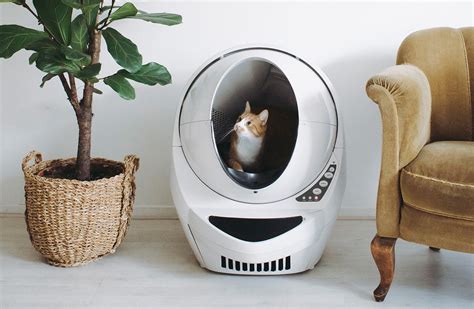Smart Cleaning Systems for a Cleaner Home
As technology advances, so too do our home appliances. Robot litter boxes are an innovative solution for pet owners who want to make litter box maintenance easier and more efficient.

Self-Cleaning Convenience
Unlike traditional litter boxes, robot litter boxes automate the cleaning process. They typically use a rotating rake or sifting mechanism to separate waste from clean litter. This feature is a significant time-saver and eliminates the need for frequent manual cleaning.
Odor Control
Robot litter boxes often incorporate odor-control systems to minimize unpleasant smells. They may use activated carbon filters, UV lights, or air purifiers to eliminate bacteria and neutralize odors.
Health Monitoring
Some advanced robot litter boxes track pet frequency and waste monitoring. This information can be valuable for detecting health issues or changes in pet behavior.
Design and Style
Robot litter boxes come in various designs and styles to match any home décor. They are generally larger than traditional litter boxes to accommodate the cleaning mechanism. However, manufacturers offer a range of sizes and shapes to suit different spaces.
Automatic Robot Litter Boxes VS Manual Litter Boxes
| Feature | Automatic Robot Litter Boxes | Manual Litter Boxes |
|---|---|---|
| Cleaning | Automatic, hands-free | Manual, daily scooping |
| Odor Control | Built-in systems (filters, UV lights) | Limited odor control |
| Health Monitoring | Some advanced models | Not available |
| Convenience | Minimal effort required | Requires daily maintenance |
| Cost | Typically higher | Typically lower |
Step-by-Step Guide to Choosing a Robot Litter Box
- Determine Your Budget: Robot litter boxes vary in price, so set a budget before shopping.
- Consider Size and Capacity: Choose a size that fits your pet and the available space. Consider capacity for multiple pets.
- Review Cleaning Features: Evaluate the different cleaning mechanisms and odor-control systems available.
- Check for Health Monitoring Capabilities: If desired, look for models that offer frequency and waste monitoring.
- Read Reviews and Ratings: Research different models and read reviews from other pet owners.
Pros and Cons of Robot Litter Boxes
Pros:
- Convenient and hands-free operation
- Improved odor control
- Health monitoring capabilities
- Less mess and hassle
- Peace of mind for pet owners
Cons:
- Higher cost than traditional litter boxes
- Requires periodic maintenance and cleaning
- May not be suitable for all pets or households
FAQs on Robot Litter Boxes
- How often do I need to change the litter in a robot litter box? Typically, you will need to replace the litter every 2-3 weeks.
- Can I use any type of litter in a robot litter box? No, most robot litter boxes require specific types of litter that are compatible with their cleaning mechanisms.
- How do I maintain my robot litter box? Regular maintenance includes emptying the waste drawer, cleaning the rake or sifting mechanism, and replacing the litter as needed.
- Are robot litter boxes suitable for all pets? Yes, they are generally suitable for cats of all ages and sizes, but it’s always best to consult your veterinarian if you have any concerns.
- How much do robot litter boxes cost? Prices vary depending on features and size, but they typically range from $200 to $600.
- Do robot litter boxes really work? Yes, robot litter boxes effectively clean and maintain litter boxes, making them an excellent choice for pet owners who prioritize convenience and cleanliness.
Market Insights on Robot Litter Boxes
The global robot litter box market is expected to grow significantly over the next few years. According to a report by MarketWatch, the market size is projected to reach $2.5 billion by 2025. This growth is driven by factors such as increasing pet ownership, rising disposable income, and growing awareness of the benefits of these devices.
Case Study: PetSafe ScoopFree Ultra Self-Cleaning Litter Box
The PetSafe ScoopFree Ultra Self-Cleaning Litter Box is a popular and highly-rated robot litter box. It uses a disposable tray filled with crystal litter that absorbs and dehydrates waste, eliminating odors. The tray is automatically replaced every 2-3 weeks.
Benefits:
- Odor-free guarantee: The crystal litter effectively neutralizes odors.
- Mess-free operation: The disposable tray design ensures easy cleaning.
- Health monitoring: The litter box tracks waste frequency and alerts you to potential health issues.
Considerations:
- Higher cost: The disposable trays can add to the ongoing cost of the litter box.
- May not be suitable for all cats: Some cats may not adapt to the crystal litter.
Conclusion
Robot litter boxes are an innovative solution for pet owners seeking convenience, odor control, and health monitoring capabilities. They offer a variety of benefits, from automated cleaning to improved hygiene. While they may come with a higher cost, they provide significant value by saving time, reducing mess, and promoting a cleaner and healthier environment for both pets and owners.





















